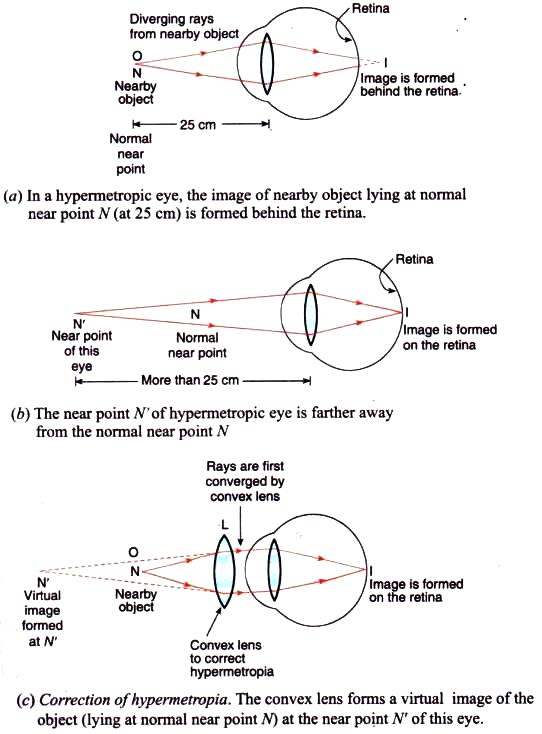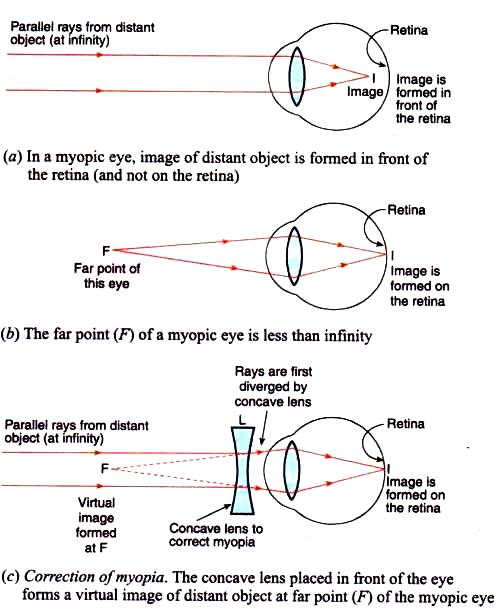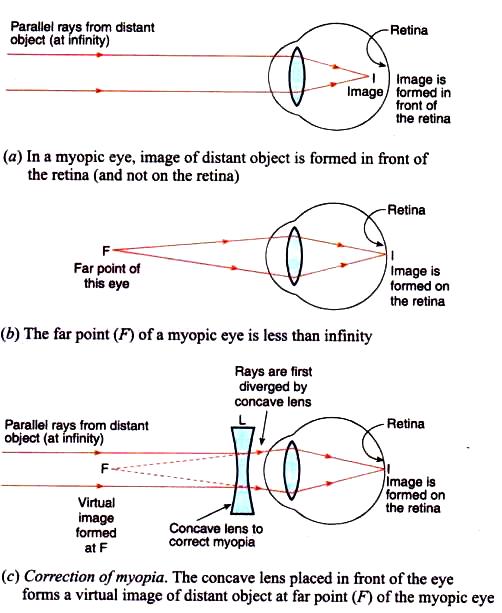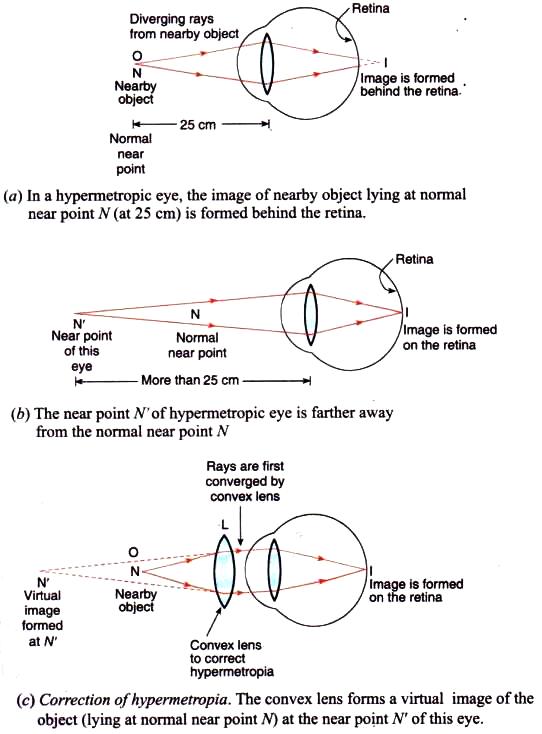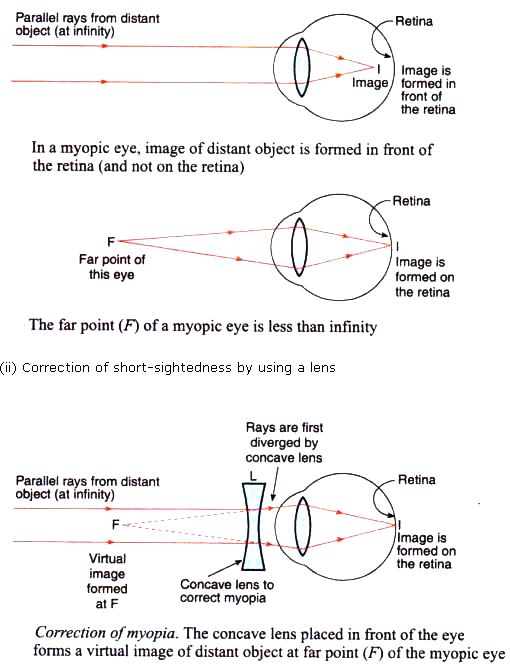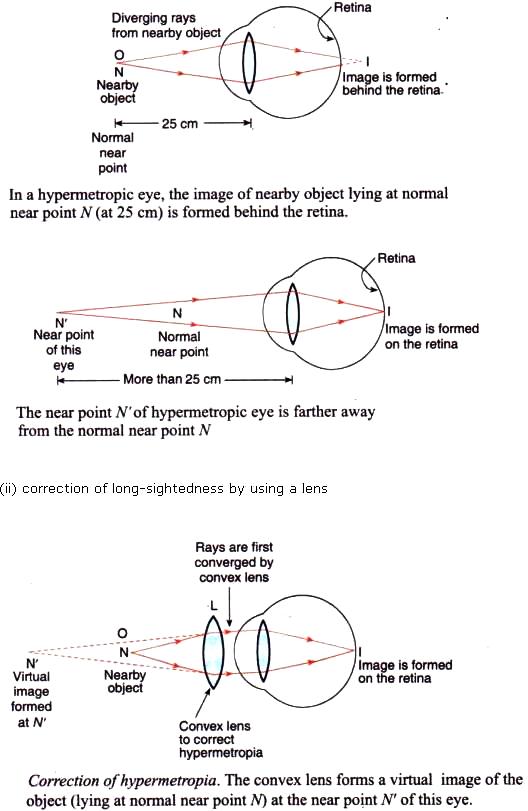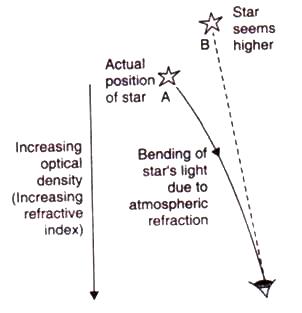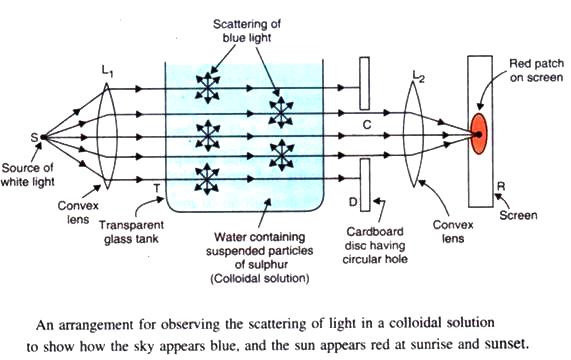Class 10 LAKHMIR SINGH AND MANJIT KAUR Solutions Physics Chapter 6 - The Human Eyes And The Colorful World
The Human Eyes And The Colorful World Exercise 269
Solution 1
Convex lens
Solution 2
Two parts which refract light rays are cornea and eye-lens.
Solution 3
(a) Iris
(b) Retina
(c) Ciliary muscles
Solution 4
(a) Cornea
(b) Retina
Solution 5
At retina
Solution 6
Eye lens changes its shape and thickness to focus light on to the retina.
Solution 7
Pupil expands or contracts according to the intensity of light around the eye.
Solution 8
The pupil of our eye contracts.
Solution 9
Retina
Solution 10
Blind spot
Solution 11
Retina
Solution 12
Rods and cones
The Human Eyes And The Colorful World Exercise 270
Solution 13
(a) Cones
(b) Rods
Solution 14
True
Solution 15
The principal function of the eye-lens is to focus light on to the retina.
Solution 16
At cornea
Solution 17
Ciliary muscles
Solution 18
The ciliary muscles make the eyes lens thicker (more converging).
Solution 19
The least distance of the distinct vision for a normal human eye is about 25cm.
Solution 20
(a) The far point of a normal human eye is at infinity.
(b) The near point of a normal human eye is at 25cm from the eye.
Solution 21
Range of vision of a normal human eyes is from infinity to about 25cm.
Solution 22
Ciliary muscles
Solution 23
The ability of an eye to focus the distant objects as well as the nearby objects on the retina by changing the focal length of its lens is called the power of accommodation.
Solution 24
(a) Optic nerve
(b) Ciliary muscles
(c) Pupil
(d) Cornea
(e) Eye lens
Solution 25
(a) cornea
(b) retina
(c) iris
(d) large
(e) light
(f) eye-lens
(g) thinner
(h) thicker
Solution 26
The normal eye is not able to see clearly the objects placed closer than 25 cm because all the power of accomodation of the eye is exhausted at a distance of 25 cm. The maximum accomodation of the eye is reached when the object is placed at 25 cm fro the eye. After this the ciliary muscles cannot make the eye-lens more thick.
Solution 27
(a) Eye-lens becomes thicker.
(b) Eye-lens become thinner.
Solution 28
(a) When the eye is focused on a distant object.
(b) When the eye is focused on a nearby object.
Solution 29
To focus on distant objects, the ciliary muscles of the eye get fully relaxed and pull the suspensory ligaments attached to the eye-lens tightly. This, in turn, stretches the eye-lens and the eye-lens becomes thin.
To focus on nearby objects, the ciliary muscles of the eyes contract and make the suspensory ligaments loose. The ligaments then stop pulling the eye-lens. The eye-lens bulges under its own elasticity and becomes thick.
Solution 30
The amount of light entering the eye is controlled by the iris. It automatically adjusts the size of the pupil according to the intensity of light received by the eye. If the amount of light received by the eye is large, then the iris contracts the pupil and reduces the amount of light entering the eye. If the amount of light received by the eye is small, then the iris expands the pupil so that more light may enter the eye.
Solution 31
When we enter a darkened cinema hall from bright sunshine, at first we cannot see anything clearly. After a short time our vision improves. This is because in bright sunshine the pupil of our eye is small and when we just enter the darkened room very little light enters our eye due to which we cannot see properly. After a while, when the pupil of our eye expands, more light enters our eye and we can see clearly.
Solution 32
It takes some time to see objects in a dim room when we enter the room from bright sunshine outside because it takes some time to the small pupil of our eye to become large so that more light enters our eye and we can see clearly.
The Human Eyes And The Colorful World Exercise 271
Solution 33
(a) Pupil becomes smaller.
(b) The amount of light entering the eye is reduced.
Solution 34
Ciliary muscles get relaxed and the eye lens becomes thin when the eye is looking at a distant object, and these muscles contract and make the eye-lens thick when the eye is looking at a nearby object. Thus, ciliary muscles help in the normal functioning of the eye by changing the thickness of the eye-lens while focussing.
Solution 35
To focus on distant objects, the ciliary muscles of the eye get fully relaxed and pull the suspensory ligaments attached to the eye-lens tightly. This, in turn, stretches the eye-lens and the eye-lens becomes thin. This thin eye-lens has large focal length and small converging power sufficient to converge the parallel rays of light coming from a distant object to form an image on the retina.
To focus on nearby objects, the ciliary muscles of the eyes contract and make the suspensory ligaments loose. The ligaments then stop pulling the eye-lens. The eye-lens bulges under its own elasticity and becomes thick. This thick eye-lens has small focal length and large converging power which converges the diverging rays coming from the nearby object to form an image on the retina.
Solution 36
(a) The two types of light-sensitive cells are found in the retina.
(b) They are called rods and cones.
(c) Rods are sensitive to dim light and cones are sensitive to bright light and colours.
Solution 37
Rods are the rod-shaped cells present in the retina of an eye which are sensitive to dim light.
Cones are the cone-shaped cells present in the retina of an eye which are sensitive to bright light.
Our night vision is relatively poor compared to the night vision of an owl due to the presence of relatively smaller number of rod cells in the retinas of our eyes.
Solution 38
(a) The focal length of the convex eye-lens can be changed by the action of ciliary muscles, but the focal length of the ordinary convex lens made of glass is fixed.
(b) Cornea, pupil, eye-lens, retina.
Solution 39
(a) (i) In dim light, pupil becomes large.
(ii) in bright light, puoil becomes small.
(b) (i) Cones
(ii) Rods
(iii) Cones
Solution 40
(a)
(b) Working of the human eye
The light rays coming from the object kept in front of the eye enter the cornea, pass through the pupil and fall on the eye lens. The eyes lens is convex lens, so it converges the light rays and produces a real and inverted image of the object on the retina. The image formed on the retina is conveyed to the brain by the optic nerve and gives rise to the sensation of vision.
(c) The eye adjusts itself to deal with ight of vaying intensity with the help of the iris. The iris automatically adjusts the size of the pupil according to the intensity of light received by the eye. If the intensity of light is large, then iris contracts the pupil and reduces the amount of light entering the eye. And, if the intensity of light is small, then iris expands the pupil so that more light may enter the eyes.
Solution 41
(a) a. Cornea: It is the fromt part of the eye. The light coming from objects enters the eye through cornea.
b. Iris: It controls the amount of light entering the eye.
c. Pupil: It controls the illumination in the eye.
d. Ciliary muscles: The focal length of the eye-lens can be changed by changing its shape by the action of ciliary muscles.
e. Eye-lens: It focuses light on to the retina.
f. Retina: It is a delicate membrane having a large number of light sensitive cells called 'rods' and 'cones' which respond to the intensity of light and colour of objects respectively.
g. Optic nerve: It conveyes the image formed on the retina to the brain.
(b) If we walk from a dark room into sunlight, the pupil of the eye contracts. On again entering the dark room, the pupil of the eye expands.
(c) When we enter a darkened cinema hall from bright sunshine, at first we cannot see our seats clearly but gradually they become visible. This is because in bright sunshine the pupil of our eye is small and when we just enter the darkened room very little light enters our eye due to which we cannot see properly. After a while, when the pupil of our eye expands, more light enters our eye and we can see clearly.
The Human Eyes And The Colorful World Exercise 272
Solution 53
(i) d
(ii) c
(iii) a
(iv) e
(v) b
Solution 54
(a) Thick
(b) Thin
Solution 55
Irises help to protect the retinas of our eyes from damage by bright light by adjusting the size of the pupil according to the intensity of light received by the eye.
Solution 56
(a) Cornea and eye-lens
(b) Cornea
(c) Eye lens
By changing its thickness and hence conversing power.
Solution 57
Ciliary muscles should change the shape of eyes-lens to make it thicker and increase its converging power.
Solution 58
The eye-lens does not have to do all the work of converging incoming light rays because cornea of the eye also converges light rays entering the eye.
Solution 59
The color detecting cells of the retina of the eye called 'cones' do not work well in dim light.
Solution 60
Wide pupils allow more light to enter the eye during night.
Rod cells in the retina are sensitive to dim light and hence help in seeing properly at night.
The Human Eyes And The Colorful World Exercise 279
Solution 1
Defect: Myopia; Corrected by using concave lens.
Solution 2
(a) Hypermetropia
(b) Myopia
Solution 3
(a) Myopia
(b) Hypermetropia
Solution 4
(a) Convex lens
(b) Concave lens
Solution 5
(A) Near Sightedness
(B) Far Sightedness
Solution 6
(a) Myopia
(b) Hypermetropia
Solution 7
(a) Concave lens
(b) Convex lens
Solution 8
True
Solution 9
Presbyopia
Solution 10
Cataract
Solution 11
Presbyopia
Solution 12
(a) Myopia
(b) Hypermetropia
Solution 13
Cataract
Solution 14
Eye
Solution 15
Less than infinity.
Solution 16
The near point of a person suffering from hypermetropia is farther away from the normal near point (25 cm).
Solution 17
(a) Short-sighted
(b) Diverging lenses
Solution 18
(a) Hypermetropia (Long Sightedness)
(b) Convex lens
Solution 19
(a) Myopia (Short - Sightedness)
(b) Concave lens
Solution 20
(a) distant, concave
(b) nearby, convex
Solution 21
The two most common defects of vision are myopia and hypermetropia. Myopia can be corrected by using a concave lens and hypermetropia can be corrected by using a convex lens.
Solution 22
In myopia, a person can see nearby objects clearly but cannot see distant object clearly. In hypermetropia, a person can see distant objects clearly but cannot see nearby objects clearly.
A person having the defects of myopia as well as hypermetropia should wear spectacles having bifocal lenses in which upper part consists of concave lens and lower part consists of convex lens.
The upper part corrects myopia and the lower part corrects hypermetropia.
Solution 23
Hypermetropia can be corrected by a converging lens.
Correction of hypermetropia is given in the following diagram:
The Human Eyes And The Colorful World Exercise 280
Solution 24
Myopia can be corrected by a diverging lens.
Correction of myopia is given in the following diagram:
Solution 25
Myopia or short sightedness is that defect of vision due to which a person cannot see the distance objects clearly (though he can see the nearby objects clearly). This eye defect can be corrected by using a concave lens.
Myopic eye and its correction is given in the following diagrams
Solution 26
Hypermetropia (or long-sightedness) is that defect of vision due to which a person cannot see the nearby objects clearly (though he can see the distant object clearly). This eye defect can be corrected by using a convex lens.
Hypermetropic eye and its correction is given in the following diagrams:
Solution 27
The person needs a concave lens to rectify this defect.
Calculation of power of the lens:
Solution 28
The person needs a convex lens to rectify this defect.
Calculation of power of the lens:
This hypermetropic eye can see the nearby object kept at 25 cm clearly if the image is formed at its own near point i.e. 50 cm.
Solution 29
(i) For distant vision:
P = -5.5D
P = 1/f
f = 1/P = 1/(-5.5) = -0.1818 m = -18.18cm
(ii) For Near Vision:
P = 1.5D
P = 1/f
f = 1/P = 1/1.5 = 0.6666 = 66.66 cm
Solution 30
Presbyopia is that defect of vision due to which an old person cannot see the nearby objects clearly due to loss of power of accommodation of the eye.
Causes: Gradual weakening of the ciliary muscles and diminishing flexibility of the eye lens.
It can be corrected by using convex lenses.
Solution 31
A person is said to have developed cataract when the eye lens becomes progressively cloudy resulting in blurred vision.
The vision of a person having cataract can be restored after getting surgery done on the eye having cataract. The opaque lens is removed from the eye by surgical operation and a new artificial lens is inserted in its place.
Solution 32
long, concave, short, convex, retina
Solution 33
(a) Short Sightedness is that defect of vision due to which a person can see nearby objects clearly but cannot see distant objects clearly.
Causes:
1. Excessive curvature of the eye lens
2. Elongation of the eyeball
Ray diagram for:
(i) eye-defect short sightedness
(b) Concave lens should be used to restore proper vision.
Calculation of power:
Solution 34
(a) Long-sightedness is that defect of vision due to which a person cannot see the nearby objects clearly but he can see the distant objects clearly.
Causes:
1. Focal length of the eye lens is too long.
2. The eyeball has become too small.
Ray diagram for:
(i) eye-defect long-sightedness
(b) The person needs a convex lens to rectify this defect.
Calculation of power of the lens:
The eye is long-sighted.
(c) Concave lens is required.
Calculation of power:
The eye is short-sighted.
The Human Eyes And The Colorful World Exercise 281
Solution 47
If the spectacle lenses are convex, the person was long sighted and if the spectacle lenses are concave, the person was short sighted.
Solution 48
Half moon spectacles are used for reading. so, the person has long-sightedness.
These particular spectacles are useful to him since the convex lenses of spectacles form the image of nearby object (like a book in hand) at the near point of his eye.
Solution 49
(a) (i) No, (ii) Yes, (iii) No
(b) Concave lenses
Solution 50
(a) (i) No, (ii) Yes
(b) Converging lenses
Solution 51
(a) Presbyopia
(b) Hypermetropia
The Human Eyes And The Colorful World Exercise 283
Solution 1
(a) About 150o
(b) About 180o
Solution 2
Animals having two eyes on the opposite sides of their head.
Solution 3
(i) Predators
(ii) Animals of prey
Solution 4
True
The Human Eyes And The Colorful World Exercise 284
Solution 5
(a) wider
(b) distances
Solution 6
Following are the advantages of having two eyes instead of one:
1. Having two eyes gives a wider field of view.
2. Having two eyes enables us to judge distances more accurately.
Solution 7
A person who has lost the sight of one eye has a narrower field of view than the normal person who has two good eyes. Also, the person with one eye cannot judge distances accurately.
Solution 8
(a) Rabbit, deer
(b) Tiger, lion
Solution 9
The predators (like lions) have their eyes facing forward at the front of their heads, whereas the animals of prey (like rabbit) usually have eyes at the sides of their head so that they can see their enemies (predators) in a very large area around them and try to escape from them.
Solution 10
(a) A and C
(b) B, D and E
The Human Eyes And The Colorful World Exercise 288
Solution 1
Towards the normal
Solution 2
Away from the normal
Solution 3
Rainbow
Solution 4
Sunlight consists of seven colours.
Solution 5
Newton demonstrated by his experiments with the prisms that white light consists of a mixture of seven colours.
Solution 6
Solution 7
The seven colours of the spectrum of white light are denited by the word VIBGYOR where V stands for Violet, I for Indigo, B for Blue, G for Green, Y for Yellow, O for Orange and R for Red.
It is connected with the phenomenon of dispersion of light.
Solution 8
(i) Red
(ii) Violet
Solution 9
Yellow and Blue
Solution 10
Newton
Solution 11
Red, Orange, Yellow, Green, Blue, Indigo and Violet
Solution 12
(a) Red
(b) Violet
Solution 13
Red Light
Solution 14
Violet
Solution 15
(a) towards, away from
(b) seven, violet
Solution 16
(i)
(ii)
(iii) Different coloured rays deviate differently in a prism because different colours travel at different speeds through the glass prism.
The Human Eyes And The Colorful World Exercise 289
Solution 17
(a) When a ray of ordinary light is passed through a triangular glass prism, it splits to form a band of seven colours.
(b) If another similar glass prism is placed upside down behind the first prism, then the seven coloured rays from the first prism which are incident on the second prism recombine to form the original white beam.
Solution 18
Yes, it is possible to recombine the lights of seven colours to obtain the white light again by placing another similar prism alongside the first one in the inverted position as shown below.
The first prism disperses the white light into seven coloured rays. the second prism receives all the seven coloured rays from the first prism and recombines them into original white light. This is because the refration produced by the second prism is equal and opposite to that produced by the first prism.
Solution 19
(a) The band of seven colours formed on a white screen, when a beam of white light is passed through a glass prism is called spectrum of white light. A glass prism is used to produce a spectrum.
(b) There are seven colours in the spectrum of white light. The colours are Red, Orange, Yellow, Green, Blue, Indigo and Violet.
Solution 20
The splitting up of white light into seven colours on passing through a transparent medium like a glass prism is called dispersion of light.
Formation of rainbow:
The raindrops act like small prisms. When sunlight enters and leaves these raindrops, the various coloured rays in white light are refracted by different amounts due to which an arc of seven colours called rainbow is formed.
Solution 21
(a) (i) violet (ii) Red
(b) Different colours of white light bend through different angles because different colours travel through different speeds through in the glass prism.
Solution 24
Solution 25
Solution 26
Solution 27
(a)
(b) Rainbow is an arch of seven colours visible in the sky which is produced by the dispersion of sun's light by raindrops in the atmosphere. A rainbow is formed in the sky when the sun is shining and it is raining at the same time.
(c) Raindrops
(d) Dispersion of light
(e) Red, Orange, Yellow, Green, Blue, Indigo and Violet.
Solution 22
Solution 23
Refraction:
Dispersion:
The Human Eyes And The Colorful World Exercise 290
Solution 38
Because a flat pane of glass has parallel sides.
Solution 39
(a) White Paper
(b) Blackboard
Solution 40
Formation of the rainbow in the sky
The Human Eyes And The Colorful World Exercise 292
Solution 1
Atmospheric refraction of light
Solution 2
Twinkling of stars; Advance sunrise and delayed sunset
Solution 3
(a) Atmospheric refraction of sunlight
(b) Atmospheric refraction of sunlight
Solution 4
(a) About 2 minutes
(b) About 2 minutes
Solution 5
False
Solution 6
Atmospheric refraction of light
Solution 7
two, two, refraction
Solution 8
Stars seem higher than they actually are because of atmospheric refraction of light coming from the star while passing through the successive denser layers of earth's atmosphere.
Solution 9
The sun can be seen about two minutes before actual sunrise because of atmospheric refraction of sun's light as shown in the following diagram. When the sun is slightly below the horizon, then the sun's light coming from less dense air to more dense air is refracred downwards as it passes through the atmosphere and the appears to be raised above the horizon.

Fig. shows the effect of atmospheric refraction at sunrise.
Solution 10
The air just above the fire becomes hotter. This hotter air is optically rarer but the colder air further up is optically denser, so when we see the objects by the light coming from them through hot and cold air layers having different optical densities, then refraction of light takes place randomly due to which the objects appear to be moving slightly.
Solution 11
(a) The refraction of light caused by the earth's atmosphere is called atmospheric refraction. It is caused due to the varying optical densities of different layers of earth's atmosphere.
(b) The light coming from a star undergoes atmospheric refraction due to varying optical densities of air at various altitudes. The continuously changing atmosphere refracts the light from the star by different amounts from one moment to the next. Thus, the star-light reaching our eyes increases and decreases continuously and the star appears to twinkle.
(c) Planets appear to be quite big to us and can be considered to be a collection of a very large number of point sources of light. The dimming effect produced by some of the point sources is nullified by brighter effect produced by some other point sources. Thus, the overall brightness remains the same and the planets do not appear to twinkle.The Human Eyes And The Colorful World Exercise 293
Solution 20
The atmosphere only contains air but all the air in the atmosphere is not at the same temperature. Some of the air layers are cold whereas others are comparatively warm. The cooler air layers of the atmosphere behave as optically denser medium for the light rays whereas the warmer air layers behave as optically rarer medium. So, light gets refracted on passing through these layers of air in the atmosphere.
Solution 21
By about 4 minutes
Solution 22 (a)
(a) This means that due to atmospheruc refraction we continue to see the sun about two minutes after the actual sunset. No such atmospheric refraction could have been possible if the earth had no atmosphere. Hence, the day is longer due to the atmosphere of earth.
(b) Yes
The Human Eyes And The Colorful World Exercise 297
Solution 1
(a) White
(b) Blue
Solution 2
Light of shorter wavelengths
Solution 3
(a) False
(b) True
Solution 4
Dark or black
Solution 5
Tyndall effect
Solution 6
Two effects produced by the scattering of light by the atmosphere are:
-Sky appears blue.
-Sun appears red at sunrise and sunset.
Solution 7
The scattering of light by particles in its path is called Tyndall effect.
Ex. When a beam of sunlight enters a dusty room through a window, then its path becomes visible to us due to the scattering of the light by the dust particles present in the air.
Solution 8
When a beam of sunlight enters a dusty room through a window, then its path become visible to us. The tiny dust particles present in the air of room scatter the beam of light all around the room.
The Human Eyes And The Colorful World Exercise 298
Solution 9
The sky appears blue on a clear day because of the scattering of blue component of white sunlight by air molecules presents in the atmosphere. When sunlight passes through the atmosphere, most of the longer wavelength lights do not get scattered much and hence pass straight through the atmosphere. The shorter wavelength blue light is, however, scattered all around the sky and whichever direction we look, some of this scattered blue light enters our eyes.
Solution 10
To an astronaut, the sky looks dark and black instead of blue because there is no atmosphere containing air in the outer space to scatter sunlight. So, there is no scattered light to reach our eyes in outer space, therefore the sky looks dark and black there.
Solution 11
The sun and the surrounding sky appear red at sunrise because at that time most of the blue color present in sunlight has been scattered out and away from our line of sight, leaving behind mainly red color in the direct sunlight beam that reaches our eyes.
Solution 12
The sun and the surrounding sky appear red at sunset because at that time most of the blue color present in sunlight has been scattered out and away from our line of sight, leaving behind mainly red color in the direct sunlight beam that reaches our eyes.
Solution 13
'Danger' signls are red in colour because the red coloured light having longer wavelength is the least scattered by fog or smoke particles. Due to this the red light can be seen in the same colour even from a distance.
Solution 14
(a)
(b) Blue light scatters more easily due to its smaller wavelength.
(c) Shortest wavelength component i.e. blue light scatters away when the sun appears red at sunrise or sunset.
(d) Gas moleccules present in the air.
Solution 20
(a) Red colour is observed from the front of the glass tank. This colour corresponds to the colour of sky around the sun at sunset.
(b) Blue colour is observed from the sides of the glass tank. This colour corresponds to the colour of sky on a clear day.
Solution 21
When the sun is overhead, then the light coming from the sun has to travel a relativity shorter distance through the atmosphere to reach us. During the shorter journey of sunlight, only a little of the blue color of the white light is scattered. Since light coming from the overhead sun has almost all its component colors in the right proportion, therefore the sun in the sky overhead appears white to us.
But when the same sun is near the horizon at sunset, the sunlight has to travel the greatest distance through the atmophere to reach us. During this long journey of sunlight, most of the shorter wavelength blue colour present in it is scattered out and away from our line of sight. So, the light reaching us directly from the setting sun consists mainly of longer wavelength red colour due to which the sun appears red.
Solution 22
greater; longer; red; red

